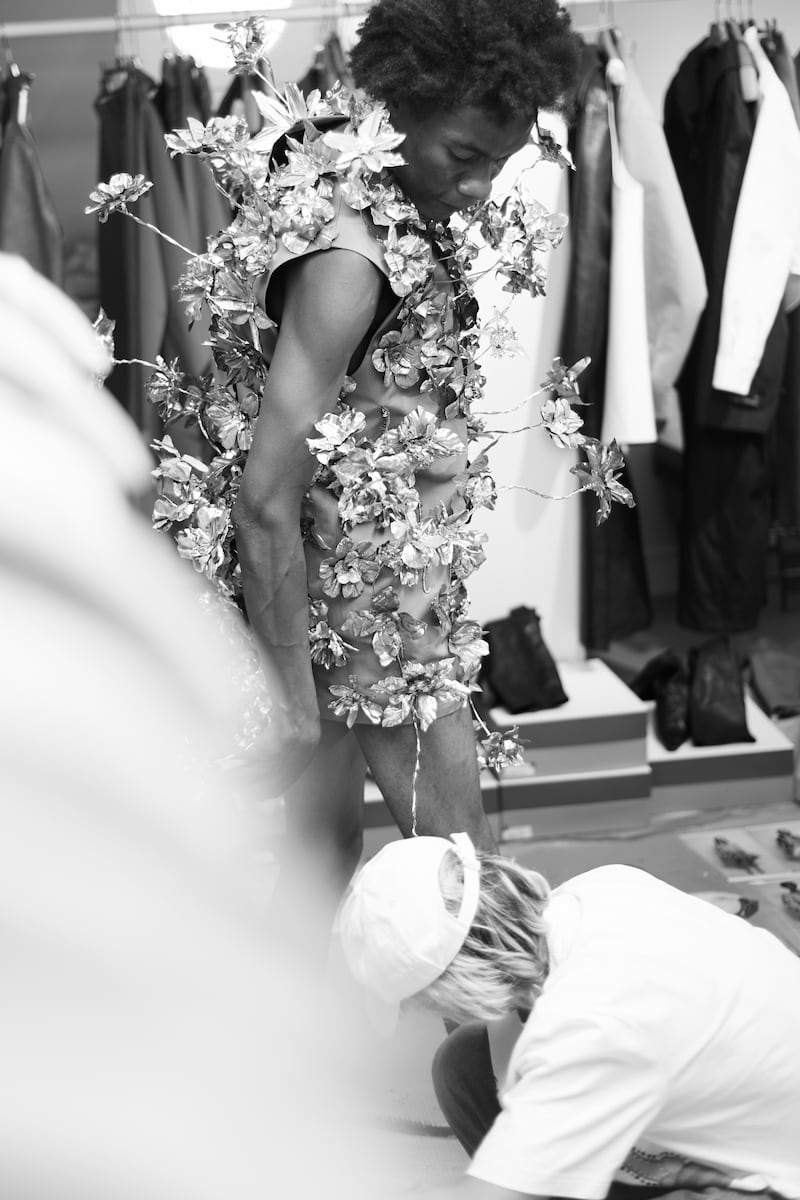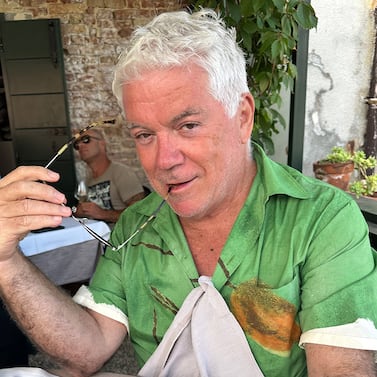
The Business of Fashion
Agenda-setting intelligence, analysis and advice for the global fashion community.

Agenda-setting intelligence, analysis and advice for the global fashion community.

PARIS — Francesco Risso and his team were prepping for Marni’s Paris debut on the top floor of brand owner OTB Group’s French headquarters. “We couldn’t not have been in an attic in Paris, right?” Risso erupted with a gleeful cackle. In the space of three days, it had been transformed into an artist’s garret, walls and ceiling covered with vivid Van Gogh-like paintings of blue skies, sunbursts and flowers. “It was a bit too … white,” Risso said.
The tiny temporary atelier was filled with clothes, shoes, bags and people. Lucia, the head seamstress, is a trained opera singer. If she broke into an aria at work, Risso said he might join her on the cello he’d learned to play during the Covid-19 lockdowns. “I wanted to learn music profoundly and seriously. When I started, I didn’t even know how to read it. Such hard practice. You can’t fuck around with the string. No shortcuts.”
Risso joined Marni in 2016 after eight years at Prada. During a preview on Monday, he had an urgent question. “Why do you think I feel like this is my first show?” The feeling had been bothering him for a month. I lamely suggested it might be Paris itself, the heartland of fashion. He’s touching down in the city after showing last season in Tokyo, the season before in New York, exploring different perspectives on Marni, enjoying the feeling of being a flâneur, a wanderer, an observer of others. “It’s been so incredible to absorb and to really decode everything that we’ve done so far. So being here feels almost like the peak of these travels, where we are celebrating together the starting points of our symphony, the starting points of everything that we’ve been doing so far. That’s why it’s super emotional for me. I don’t know if it’s Paris, because I’ve been coming here for so many years.”
Before he started working in fashion houses, Risso had a store in his hometown Genoa, where he sold labels like Azzedine, Alaïa and Comme des Garçons. He would visit Paris on buying trips. And before that, he would come to see his best friend. On one of those trips, when he was 14, he fell in love at a party. “I was sitting on the couch cradling my legs, and this guy came and rested his head on my knee, then he disappeared. It was like a frame of a second. But it was also the moment when I realised that maybe I would like to be with a boy. And all I had was the memory of his fragrance. I kept coming here for years to hunt for it in perfume shops.” He never found the scent. But the quest did give him the flâneur sensation he’s loved ever since.
ADVERTISEMENT
Risso tells the story in a handwritten letter, which serves as the invitation for Wednesday’s show.
He also revisits another teenage memory. He and his friend would spend days at the window waiting for the neighbour, Karl Lagerfeld, to emerge from his house. “For us, it was almost like seeing Michael Jackson,” he recalled. When he was scouting for a Paris location, Risso was taken to 51 Rue de l’Université. “After the whole tour, the guy said, ‘This is where Karl used to live.’ I immediately thought we have to show here. I used to see him from the window as one of the heroes of fashion. He made me think a lot about how joy is an act that requires rebellion and commitment and just work, work, work. And this collection is joy and rebellion together. I’m just in the clouds.”
0 of 62
“Joy” was the word Risso came back to a few times in our conversation. After the very different demands of showing in New York and Tokyo, I was curious about what special demands he felt Paris made. “I don’t know,” he answered. “I’m just demanding of myself to have the most passionate time of my career. Paris is the city of love, and I think we all need love. And to me, it’s also the understanding that this word ‘joy,’ which can seem quite flat and banal in this moment of terror, requires a lot of work. There’s a rail of clothes there that took months to make. It was like an exploration of fatigue and commitment and working together in order to connect people with something that is pleasurable, because that’s what we do. Is fashion just to reflect the harshness of this time? I’m so not into the virtuality. I’m into the virtuosity of the hand.”
There has always been an interesting relationship between the artisanal and the mechanical at Marni. Some of the most striking pieces in the new collection involve the mechanical: the checked knitwear, fully finished on machines in one piece with no waste. “This is something we’ve been exploring for a while now,” said Risso. “It requires a lot of technology. Only three companies in Italy can do it.” The accompanying shoes and knee socks are also one perfect piece of trompe-l’œil. Risso laughingly called the effect “The antichrist of Adidas.” “It’s the same technique they and Nike use to make their knit shoes, and it’s become one of our signatures. It’s very beautiful, you make the piece and you don’t cut it because it’s like a sock. Then you just have to reinforce some parts in order to walk properly.”
But the virtuosity of the hand comes across in the head-spinningly intricate leathers intarsia-ed into Marni checks and stripes. In one single look, the coat, trousers and top are made this way, each with a different check. There’s even a checked chiffon t-shirt, also intarsia-ed. I was exhausted just thinking about the amount of handwork. But also, it had an element of the intimate craft of couture, the details that only the wearer will be aware of. “The secret of fashion, the beauty,” Risso agreed. Then he brought out a floor-length tubular knit outfit, starkly simple by comparison. “I want to show you this because I love how, in the midst of this intense hand, there’s also the connection with the body. The body has a huge play in our happiness in life, but most of the people in the Western world don’t think that way. We ‘mentalise’ a lot in order to resolve our problems. We’re way too ‘brainy.’ It would be nice to go back to being okay with our bodies.” For the past six years, Risso has been practising Qigong every day. It’s a Tai Chi-like discipline which he feels has connected him much more with his sensory self. “Maybe that’s why I shaved my head,” he mused. “Undress the mind and dress up with the senses. I think I’m looking to connect people with that.”
The other travelling shows have had a distinct identity — New York a street-y physicality, Tokyo a counter-intuitive blend of discipline and emotion. Maybe this was what Risso meant about a “first show” when he said, “Paris is about our blueprint. We’ve re-engaged with the three ideas of Marni: stripes, checks and flowers.” And Paris was the perfect location because, as he saw it, “rebellion and cake”, two of the city’s cultural and historical props (where the sans-culottes met Marie Antoinette), also mirrored Marni’s own extremes, especially in this collection where the relative sobriety of the stripes and checks is overwhelmed by an orgasmic eruption of flowers, a true dressing up with the senses.

I guess the best analogy is découpage, “the art or craft of decorating objects with paper cut-outs.” Or, as Risso described it, “The most classical images of flowers that are sitting in our brain have been decoded, printed, cut by hand and stitched on a cotton fabric.” In fact, on both sides of a cotton fabric, because all the dresses and coats are layered inside and out with the cut-outs. “Now, this is insanity,” Risso effused. I’m telling you, this is like the celebration of insanity.” These are his cakes.
And they’re scarcely even as extreme as it gets. “How can we get even more passionate with our hand?” Risso challenged his team. “So it’s been a huge work on push it, push it, push it, push it. Start from zero and then go to the maximum of the perspective.” Some of the dresses sprout vibrating wire stems topped by metal flowers, like a three-dimensional artwork. The flowers have been cut from tin cans, Coke, Fanta and so on. Hundreds of them. And they’re sharp-edged. Weirdly beautiful but lethal. They feel like a comment on something. Or at least a half-remembered Dada art piece.
ADVERTISEMENT
Risso insisted there were no references, historical or otherwise, not even with the full skirts with their pannier-like volumes. (He did mention Marie Antoinette, after all.) “It was literally all from the flowers that we researched for months. This is again about the senses. I wanted to make pieces that would touch people at the show. So that’s why we needed to structure them so they go out and physically touch you slightly as they walk past. I think of them as an act of passion. An ecstasy of the hand.”
He thrives on any interaction. As demanding and eccentric as Risso’s work can seem, it is clearly connecting in the real world. Marni’s revenues jumped 29 percent in 2022. “I don’t work for pieces to be closed in a glass box in a museum,” he insisted. “I don’t care about that.” Marni chief executive officer Barbara Calò called Risso “a visionary, a dreamer who is passionate about conversation with clients.” She described the moment when the flower dresses left Milan for Paris in their specially designed crates. “It was the best part of the whole thing. I know all the people who made them, worked with patience to create every single flower. And they all came out to celebrate them leaving.”
I remember the last few shows in Milan before Risso began his global flâneur-y. There was a shamanic twist to them. During and immediately after the pandemic, he was one of the designers who expressed a hope for systemic change. Now, everything has reverted to business as usual. “Worse!” he wailed. “We’re still in the process of fighting against the madness. But I’m not working to make a statement. It’s really about re-engaging with the making and the craft and what we do in our factory. I don’t think you can really put in an algorithm the madness of those flowers. That’s why we do it. Because it really grounds us in what our job is about: making clothes for people to wear and to feel pleasure in.”
Editor’s Note: This article was updated to include images from Marni’s Spring/Summer 2024 show.
Mugler and Maison Margiela are also returning to the womenswear calendar after years of online shows and events during the menswear season.
The luxury group is looking to acquire new fashion brands, as well as production and distribution firms in order to expand its reach.

Tim Blanks is Editor-at-Large at The Business of Fashion. He is based in London and covers designers, fashion weeks and fashion’s creative class.
From where aspirational customers are spending to Kering’s challenges and Richemont’s fashion revival, BoF’s editor-in-chief shares key takeaways from conversations with industry insiders in London, Milan and Paris.
BoF editor-at-large Tim Blanks and Imran Amed, BoF founder and editor-in-chief, look back at the key moments of fashion month, from Seán McGirr’s debut at Alexander McQueen to Chemena Kamali’s first collection for Chloé.
Anthony Vaccarello staged a surprise show to launch a collection of gorgeously languid men’s tailoring, writes Tim Blanks.
BoF’s editors pick the best shows of the Autumn/Winter 2024 season.